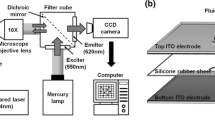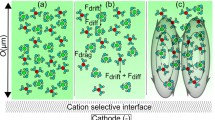Abstract
Strong microfluidic vortices are generated when a near-infrared (1,064 nm) laser beam is focused within a microchannel and an alternating current (AC) electric field is simultaneously applied. The electric field is generated from a parallel-plate, indium tin oxide (ITO) electrodes separated by 50 μm. We present the first μ-PIV analysis of the flow structure of such vortices. The vortices exhibit a sink-type behavior in the plane normal to the electric field and the flow speeds are characterized as a function of the electric field strength and biasing AC signal frequency. At a constant AC frequency of 100 kHz, the fluid velocity increases as the square of the electric field strength. At constant electric field strength fluid velocity does not change appreciably in the 30–50 kHz range and it decreases at larger frequencies (>1 MHz) until at approximately 5 MHz when Brownian motion dominates the movement of the 300 nm μ-PIV tracer particles. Presence of strongly focused laser beams in an interdigitated-electrode configuration can also lead to strong microfluidic vortices. When the center of the illumination is focused in the middle of an electrode strip, particles experiencing negative dielectrophoresis are carried towards the illumination and aggregate in this area.












Similar content being viewed by others
References
Ajdari A (2000) Pumping liquids using asymmetric electrode arrays. Phys Rev E 61:R45–R48
Ashkin A (1997) Optical trapping and manipulation of neutral particles using lasers. Proc Natl Acad Sci USA 94:4853–4860
Ashkin A, Dziedzic JM, Yamane T (1987) Optical trapping and manipulation of single cells using infrared-laser beams. Nature 330:769–771
Chakraborty S (2008) Electrothermal effects. Encyclopedia of Microfluidics and Nanofluidics. L. Dongqing, Springer, Berlin
Chiou PY, Ohta AT, Wu MC (2005) Massively parallel manipulation of single cells and microparticles using optical images. Nature 436:370–372
Curtin DM, Newport DT, Davies MR (2006) Utilising μ-PIV and pressure measurements to determine the viscosity of a DNA solution in a microchannel. Exp Thermal Fluid Sci 30:843–852
Figeys D, Pinto D (2000) Lab-on-a-chip: a revolution in biological and medical sciences. Anal Chem 72:330A–335A
Fuhr G, Schnelle T, Müller T, Hitzler H, Monajembashi S, Greulich KO (1998) Force measurements of optical tweezers in electro-optical cages. Appl Phys a-Mat Sci Process 67:385–390
Green NG, Ramos A, Gonzalez A, Castellanos A, Morgan H (2000) Electric field induced fluid flow on microelectrodes: the effect of illumination. J Phys D Appl Phys 33:L13–L17
Green NG, Ramos A, Gonzalez A, Castellanos A, Morgan H (2001) Electrothermally induced fluid flow on microelectrodes. J Electrostat 53:71–87
Gui L, Merzkirch W (1998) Generating arbitrarily sized interrogation windows for correlation-based analysis of particle image velocimetry recordings. Exp Fluids 24:66–69
Hwang H, Oh Y, Kim JJ, Choi W, Park JK, Kim SH, Jang J (2008) Reduction of nonspecific surface-particle interactions in optoelectronic tweezers. Appl Phys Lett 92:024108–024110
Inouâe S, Spring KR (1997) Video microscopy: the fundamentals. Plenum Press, New York
Jones TB (1995) Electromechanics of particles. Cambridge University Press, Cambridge
Koch M, Evans A, Brunnschweiler A (2000) Microfluidic technology and applications. Research Studies Press, Baldock
Kumar A, Ewing AH, Wereley ST (2008) Optical tweezers for manipulating cells and particles. Encyclopedia of Microfluidics and Nanofluidics. L. Dongqing, Springer, Berlin
Luo R, Sun YF, Peng XF, Yang XY (2006a) Tracking sub-micron fluorescent particles in three dimensions with a microscope objective under non-design optical conditions. Meas Sci Technol 17(6):1358–1366
Luo R,Yang XY, Peng XF, Sun YF (2006b) Three-dimensional tracking of fluorescent particles applied to micro-fluidic measurements. J Micromech Microeng (16)8:1689–1699
Meinhart CD, Wereley ST, Gray MHB (2000) Volume illumination for two-dimensional particle image velocimetry. Meas Sci Technol 11:809–814
Mizuno A, Nishioka M, Ohno Y, Dascalescu LD (1995) Liquid microvortex generated around a laser focal point in an intense high-frequency electric-field. IEEE Trans Ind Appl 31:464–468
Morgan H, Green NG (2003) AC electrokinetics: colloids and nanoparticles. Research Studies Press, Philadelphia
Müller T, Gerardino A, Schnelle T, Shirley SG, Bordoni F, DeGasperis G, Leoni R, Fuhr G (1996) Trapping of micrometre and sub-micrometre particles by high-frequency electric fields and hydrodynamic forces. J Phys D Appl Phys 29:340–349
Nakano M, Katsura S, Touchard GG, Takashima K, Mizuno A (2007) Development of an optoelectrostatic micropump using a focused laser beam in a high-frequency electric field. IEEE Trans Ind Appl 43:232–237
Papagiakoumou E, Pietreanu D, Makropoulou MI, Kovacs E, Serafetinides AA (2006) Evaluation of trapping efficiency of optical tweezers by dielectrophoresis. J Biomed Opt 11:014035-014031–014035-014037.
Pickard JE, Pries AR, Ley K (2006) Micro-PIV measurement of flow fields around adherent leukocytes. FASEB J 20:A1322–A1322
Pohl HA (1978) Dielectrophoresis: the behavior of neutral matter in nonuniform electric fields. Cambridge University Press, Cambridge
Ramos A, Morgan H, Green NG, Castellanos A (1998) Ac electrokinetics: a review of forces in microelectrode structures. J Phys D Appl Phys 31:2338–2353
Reichle C, Schnelle T, Müller T, Leya T, Fuhr G (2000) A new microsystem for automated electrorotation measurements using laser tweezers. Biochim Biophys Acta Bioenerg 1459:218–229
Reichle C, Sparbier K, Müller T, Schnelle T, Walden P, Fuhr G (2001) Combined laser tweezers and dielectric field cage for the analysis of receptor-ligand interactions on single cells. Electrophoresis 22:272–282
Rowe AD, Leake MC, Morgan H, Berry RM (2003) Rapid rotation of micron and submicron dielectric particles measured using optical tweezers. J Modern Optics 50:1539–1554
Santiago JG, Wereley ST, Meinhart CD, Beebe DJ, Adrian RJ (1998) A particle image velocimetry system for microfluidics. Exp Fluids 25:316–319
Schnelle T, Müller T, Reichle C, Fuhr G (2000) Combined dielectrophoretic field cages and laser tweezers for electrorotation. Appl Phys B 70:267–274
Simpson GJ, Wilson CF, Gericke KH, Zare RN (2002) Coupled electrorotation: two proximate microspheres spin in registry with an AC electric field. Chemphyschem 3:416–423
Trau M, Saville DA, Aksay IA (1997) Assembly of colloidal crystals at electrode interfaces. Langmuir 13:6375–6381
Wereley ST, Gui L, Meinhart CD (2002) Advanced algorithms for microscale particle image velocimetry. AIAA J 40:1047–1055
Wereley ST, Meinhart CD (2001) Second-order accurate particle image velocimetry. Exp Fluids 31:258–268
Wu M, Roberts JW, Buckley M (2005) Three-dimensional fluorescent particle tracking at micron-scale using a single camera. Exp Fluids 38(4):461–465
Acknowledgments
We would like to acknowledge support from NSF Grant CMMI-0654031. Aloke Kumar acknowledges partial support from the Adelberg Fellowship, Purdue University. S.J.W. acknowledges support under a National Science Foundation Graduate Research Fellowship.
Author information
Authors and Affiliations
Corresponding author
Rights and permissions
About this article
Cite this article
Kumar, A., Williams, S.J. & Wereley, S.T. Experiments on opto-electrically generated microfluidic vortices. Microfluid Nanofluid 6, 637–646 (2009). https://doi.org/10.1007/s10404-008-0339-8
Received:
Accepted:
Published:
Issue Date:
DOI: https://doi.org/10.1007/s10404-008-0339-8




